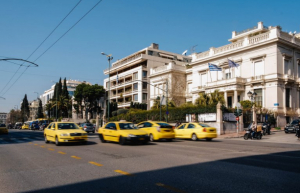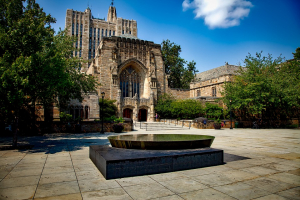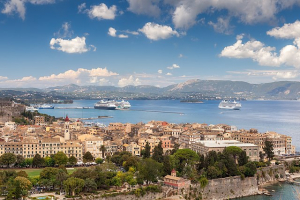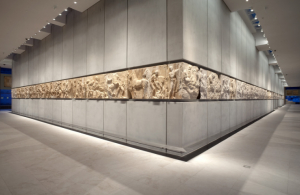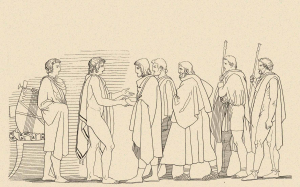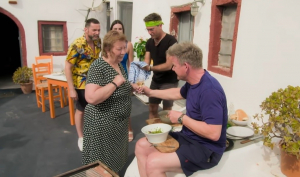LIFE & CULTURE
XpatAthens
Tuesday, 19 October 2021 07:00
What To See In Athens Museum District
Anaktora, the area between Vasilissis Sofias and Vasileos Konstantinou Avenue, may appear like a demure residential neighborhood. But there’s nothing humble about it. Within a two-kilometer perimeter, you’ll find more blockbuster museums than any other area in Athens.
At the Benaki Museum, soak up a panorama of Greek history, folk art, and culture from the prehistoric era to the 20th century. If you’ve got a little more time, head a few doors down to see the world’s most extensive collection of ancient artifacts from the Cyclades at the Museum of Cycladic Art. Also on Vasilissis Sofias Avenue, the Byzantine and Christian Museum is a trove of religious art and artifacts from icons to altarpieces, surrounded by one of the city’s loveliest secret gardens. If you’re into military paraphernalia, the National War Museum tracks Greek history through its military conflicts. (Allow for a bias towards success rather than defeat; the museum was erected by the junta as a “monument to Greek valor and military prowess”.)
Recent years have delivered three more compelling reasons to add the city’s museum district to your itinerary. First came the long-awaited Goulandris Museum of Contemporary Art which opened its doors in Pangrati in October 2019. There, visitors to Athens may gaze upon masterpieces by the likes of Cézanne, Van Gogh, Gauguin, Monet, Degas, Rodin, and Picasso, alongside works by famous Greek painters. Unearthed during construction at the gallery’s initial intended site was Aristotle’s Lyceum - one of the three famous philosophy schools of ancient Athens. It was here that Aristotle once strolled, discussing philosophy and mathematics with his students. And finally, cementing the district’s status as a nexus of both ancient and contemporary culture, the country's flagship art repository, the National Gallery, reopened in spring 2021 after a bold makeover.
This downtown neighborhood isn’t just about museums though. It’s also a corridor of political and financial power, lined by the city’s most exclusive real estate. These local sights and landmarks are definitely worth checking out in between museum-hopping.
The Presidential Mansion and the Prime Minister’s Office

Credit: Georgios Makkas
Executive power is concentrated in two splendid mansions midway down Irodou Attikou, a surprisingly tranquil street running alongside the National Garden. It’s subtly symbolic that the premier’s quarters sit just inside the gated grounds—and thus more directly accessible to the people—while the more aloof presidency is separated from the street by a wide lawn.
Evzones stand sentry outside the Presidential Mansion, designed in 1890 by Ernst Ziller as the palace of Crown Prince Constantine, but used as the president’s ceremonial residence since the monarchy’s abolition in 1974. Between state visits, the building lies dormant, except for visitors outside taking snaps of the hourly changing of the guard. Next door, the Prime Minister’s office is a hub of activity, with the media often camped outside. Known as the Maximos Mansion, it was built in 1924 as a private home. While nominally the premier’s official residence, no head of government has ever lived in it.
The Athens Conservatory

Credit: Georgios Makkas

Credit: Georgios Makkas
This sleek marble paean to the Bauhaus style was left to languish for nearly 50 years before its 5,000-square-metre music halls and stunning 150-meter porch teemed with melodies and people. Commissioned in 1959 from Jan Despo, a Greek student of Walter Gropius, the Conservatory (or Odeio, as it’s known locally) had the bad luck of being completed in 1971, four years after the junta seized power in Greece. Deemed too ‘foreign’ by the dictators, it was tainted by their brush and was not officially inaugurated until 2016.
Student activity often spills out of the 35 classrooms and two auditoria, with impromptu performances delighting young visitors to the small Hellenic Children’s Museum, housed on the ground floor. Occasional exhibitions and art fairs (such as the annual Art Athina) in the lower-level gallery add to the creative vibe.
Rizari Park

Credit: Georgios Makkas

Credit: Georgios Makkas
Commuters streaming from Evangelismos metro station trample Samuel Beckett’s Cascando, whose verses are used in an installation by artist David Harding, oblivious to the delights of this small urban park. Originally the grounds of the Rizarios Seminary, this wedge of greenery contains Roman remains, works by top contemporary artists like Giorgos Zogolopoulos, and one of the city’s oldest modern sculptures—a marble bust of Enlightenment scholar Neophytos Doukas by Christian Hansen. The Rizarios seminary was founded in 1841 by an Epirot merchant in Odessa who helped to fund the Greek War of Independence. The silver-domed Agios Georgios church next to Evangelismos station was part of the seminary. As well as interior murals by the 19th-century Corfiot artist Eleni Prosalenti, the church crypt contains Rizarios’ remains.
To read this article in full, please visit: thisisathens.org
To read this article in full, please visit: thisisathens.org
Whether you've just arrived in town – or have been here for years – Athens always has new secrets to share!
This is Athens is the official guide to this captivating city of ancient energies and booming urban culture. Compiled by a team of specialist local writers, This is Athens brings you an authentic and intimate portrait of a living Athens beyond the guidebooks – along with daily curated listings of all the best events and great weekend inspiration all-year round. From must-know neighbourhoods and emerging art hubs to gourmet hotspots, cool shopping, and the buzziest bars, This is Athens will help you to get the most out of living in Athens!
Thank you This is Athens for your contribution as an XpatAthens Partner.
Published in
City Discovery
Tagged under
Monday, 18 October 2021 07:00
Did Ancient Greeks Reach America Long Before Columbus?
The suggestion that ancient Greeks reached America before Columbus may seem far-fetched, but certain researchers think otherwise.
The idea is based entirely on a new examination of a dialogue written by the Greek historian Plutarch, who lived from 46 to 119 AD.
Dr. Ioannis Liritzis, a professor of archaeonomy (the physics of archaeology) at the University of the Aegean studied Plutarch’s text and came up with a theory that ancient Greeks did indeed reach America.
In Plutarch’s text, “On the Face Which Appears in the Orb of the Moon,” commonly known as “De Facie", Lambrias asks Sylla the Carthaginian to retell a story he had heard from the servants of the temple of Cronus in Carthage. Sylla tells Lambrias about a traveler who visited the temple after returning from a long journey to a distant, vast continent.
Greek scientist claims Greeks voyaged to America
Dr. Liritzis bases his theory on scientific data in a paper co-written with astronomer Panagiota Preka-Papadema, philosopher Konstantinos Kalachanis, meteorologist Chris Tzanis, and information technology consultant Panagiotis Antonopoulos.
Dr. Liritzis bases his theory on scientific data in a paper co-written with astronomer Panagiota Preka-Papadema, philosopher Konstantinos Kalachanis, meteorologist Chris Tzanis, and information technology consultant Panagiotis Antonopoulos.
According to the traveler in De Facie, new travelers would make the journey to the great continent roughly every 30 years, when the planet Saturn appeared in the constellation Taurus.
The researchers argue that the Greeks could have used their detailed knowledge of astronomy to pinpoint the locations of Atlantic currents that could move them westward.
A total eclipse of the sun appears in the story described by the traveler in De Facie; the Greek research team searched five millennia of eclipse records to find one that met the parameters of the dialogue.
The researchers settled on one eclipse, which took place in 75 AD. Using astronomy software, Dr. Liritzis’ team saw that in the decades around this eclipse, Saturn would have indeed appeared in Taurus during three periods: from 26 to 29 AD, 56 to 58 AD, and 85 to 88 AD.
The team used the 75 AD eclipse to calculate the timing of the conversation between Plutarch’s informant and Sylla, who had traveled to the great continent.
Based on this, Liritzis and his colleagues timed the trip itself to the period when Saturn was most recently in Taurus, i.e. 56 AD.
The researchers postulated that preparations for the journey described by Sylla would have started that year. The travelers would have arrived in North America in 57 AD.
The ancient Greeks stayed in America for a year and sailed home in the fall of 58 AD when Saturn moved out of Taurus. This was the most recent voyage to the time of Plutarch’s writing.
According to the text, such journeys must have taken place every 30 years over a span of several centuries, the Greek team assumes.
Geographic descriptions support the theory
Analysis of De Facie takes clues from the geographic descriptions made at the time as well. Plutarch’s text mentions a “great continent” beyond the isle of Ogygia, which, according to the text, is itself a five-day trip by trireme west from Britain.
Plutarch also wrote that the Greek settlers accessed the “great continent” through a bay that lines up with the Volga River delta, the northern entrance to the Caspian Sea.
Liritzis referred to Google Earth and drew a line from this location across the Atlantic, and found it led to the Gulf of St. Lawrence in Canada.
The scientist says the ancient Greek settlers may have journeyed to today’s America for the sake of exploration, for riches, or for religious purposes.
He says that they would have made the journey when Saturn was in Taurus because they closely followed astronomical phenomena associated with Kronos, the father of Zeus.
The Antikythera Mechanism, a sort of astronomical computer for ancient Greeks, supports the theory that they followed the movements of the stars and planets closely.
To read this article in full, please visit: greekreporter.org
To read this article in full, please visit: greekreporter.org
Published in
Greek Philosophy & History
Tagged under
Monday, 18 October 2021 07:00
Athens University & Yale To Offer Joint Degrees
The universities of Athens and Yale have signed a memorandum of understanding in an initiative spearheaded by two Greeks, UoA professor of analytical chemistry Nikolaos Thomaidis and epidemiology professor Vasilis Vasiliou from the American university.
The initiative foresees two joint studies programs, one at the undergraduate level in environmental sciences and public health, and a master’s degree in environmental health.
Set to launch in the 2022-2023 academic year, the programs will be conducted in English and entail tuition fees, while graduates will come out with a double degree from both institutions.
The UoA and Yale also plan a center of excellence in environmental and public health studies bringing together research teams from the two universities. Joint papers have already been submitted on the subject of Covid-19, as a precursor to this initiative.
Originally published on: ekathimerini.com
Published in
Local News
Tagged under
Friday, 15 October 2021 07:00
Greek Stuffed Eggplant Recipe
Greek stuffed eggplant or Melitzanes papoutsakia as they are called in Greece is a Greek dish that receives its name from the resemblance of its shape with little shoes. The taste and the ingredients used for this ‘Papoutsakia’ recipe are very similar to the popular Greek dish moussaka.
Extra juicy and absolutely delicious, this aubergine-based traditional recipe will certainly amaze you!
Ingredients
- 5 eggplants
- 500g minced beef
- 1 large red onion, finely chopped
- 2 cloves of garlic, finely chopped
- 1 glass of red wine
- 1 tin chopped tomatoes or tomato juice (passata)
- 1 cinnamon stick
- 1 tsp oregano
- 100g grated kefalotyri or any hard yellow cheese
- olive oil
- salt
- freshly ground pepper
- 2–3 tbsps chopped parsley
- 100g flour
- 100g butter
- 900ml milk (3 and 3/4 cups)
- 2 egg yolks
- a pinch of nutmeg
- 4 large potatoes, boiled
- 50g milk
- 1 tbsp butter
- 2 egg yolks
Instructions
- Cut the eggplants into two pieces and carve them crosswise (the flesh). Season the eggplants and place them in a colander for about half an hour. Wash them with plenty of water and drain them on some kitchen paper.
- Preheat the oven to 200C. Season the eggplants with salt and pepper and drizzle with olive oil. Place the eggplants (with the skin facing up) in a baking tray, lined with parchment paper. Bake the eggplants for 40 minutes, until softened.
- In the meantime, prepare the meat sauce for the ‘papoutsakia’. Peel and chop the onions and garlic. Place a large pan on medium heat, add some olive oil and the onions and sauté, until softened. Stir in the garlic and sauté. Turn the heat up, add the minced beef breaking it up with your spoon and sauté. Deglaze with the red wine and wait 1-2 minutes to evaporate. Stir in the canned tomatoes, the cinnamon stick, a pinch of sugar, the oregano, and season. Bring to the boil, turn the heat down and simmer with the lid on for about 30 minutes, until most of the juices have evaporated. In the end, add 1-2 handfuls of grated cheese and chopped parsley and stir.
Published in
Greek Food & Diet
Tagged under
Friday, 15 October 2021 07:00
Athens Grant Walk: Downtown to Get Green Makeover
The redevelopment of central Athens’ Panepistimiou Avenue is part of a general urban redevelopment plan. So far the makeover has included park projects, pedestrian walkways, and major city square overhauls.
After major construction works on the central street of the capital, 19,360 square meters will be redeveloped. Athens will, presumably, have more aesthetically modernized and environmentally valuable public space after the renovation.
To enhance sustainable mobility by expanding existing sidewalks, 4270 square meters will be allocated for pedestrians, according to the makeover project. Another 2260 square meters of Athens green space (large flower beds with shrubs and seasonal plants), will be created.
A total of 87 new large plane trees are to be planted along Panepistimiou Avenue, lining both sides of the street. The Panepistimiou renovation has a budget of €3 million euros and is a plan Athens mayor Kostas Bakoyiannis believes in.
Upgrading Athens’ standard of living
The makeover aims to upgrade the standard of living in the urban center, the municipality says, making it more accessible and friendlier to Athens residents and visitors.
This stage of the project comes after the recent start of renovation work on the lower part of Athens’ Syntagma Square. The makeover renovations are scheduled to begin at the end of the year.
The works will continue for a period of up to 15 months, the Athens municipality announced. The makeover will allegedly follow the example of similar urban plans implemented in Berlin and Paris.
In an effort to clarify a number of issues (and take the pulse of the reactions), the Athens municipality has launched an FAQ series covering questions on the makeover project.
Athens authorities are noting that the disruption will be as little as possible in the capital. They have announced that works will be carried out in segments.
To read this article in full, please visit: greekreporter.com
To read this article in full, please visit: greekreporter.com
Published in
Local News
Tagged under
Thursday, 14 October 2021 07:00
New Tram Service Ready To Start In Piraeus
A new tram service set to initially connect the port of Piraeus with Neo Faliro is scheduled to take off next month, said Deputy Infrastructure and Transport Minister George Karagiannis this week
.
.
Speaking on SKAI radio, the minister admitted there were problems but went on to say that the government was committed to resolving issues and moving ahead with the tram, which “starts its routes to Piraeus in November. It will run a circular route from Neo Faliro with 12 new stations. Virtually the whole of Piraeus will be served.
Karagiannis said the ministry was implementing a comprehensive transportation and traffic plan, and also announced the creation of a transportation observatory.
Among others, work was proceeding for the completion of the Metro line to Athens International Airport from Piraeus.
“By the summer of 2022, in July, all three remaining stations will be ready – Piraeus, Municipal Theater, and Maniatika [stations]. So, the largest port in the country will be connected to the airport in under 50 minutes,” he said, adding that it will help ease traffic and improve the quality of life.
In this direction, the minister went on to refer to other transport infrastructure projects including the completion of the Western Egaleo ring-road, the extension of the suburban railway (proastiakos), the extension of the Metro towards western Athens suburb Ilion, the upgrade of the Athens-Corinth roadway as well as the extension of the Attiki Odos motorway towards Kymis Avenue.
Referring to Athens Metro Line 4 budgeted at 1.2 billion euros and funded by EU resources to cover the transportation needs of some 340,000 people daily, the minister said it will change the commuting habits in Attica.
Lastly, Karagiannis said a strategy was being drawn up to address traffic congestion in the center of Athens. Under the odd/even traffic regulation system dubbed the “green daktylios”, cars will be allowed entry into the city center based on plate number with the exception of electric vehicles.
Originally published on: news.gtp.gr
Originally published on: news.gtp.gr
Published in
Local News
Tagged under
Friday, 13 October 2023 07:00
Best Greek Islands To Visit In October
Most people tend to think that Greece is mainly a summer destination, thanks to its numerous wonderful islands and sun-drenched beaches. Indeed, summer in Greece is an awesome experience, however, the country is a year-round destination, and, not only that, but it's especially beautiful during the shoulder seasons, spring and autumn.
October, in particular, seems to be a rather popular month for people to visit Greece, as the weather is much warmer than most other places in Europe and it can be a great off-season break. Here's a list of our favorite Greek islands to visit this October!
Hydra

@greeceintrips
The cosmopolitan island of Hydra is the perfect weekend getaway, thanks to its close proximity to Athens. Upon visiting the island, it's like taking a journey back in time because there are no cars there, and people get around by donkeys! Among others, you will certainly admire nature, the neoclassical architecture, and the island's sincere authenticity. Hydra is also considered an ideal hiking destination, with a network of trails expanding over 80kms all around the island.
Corfu

@katsinis.photo
Corfu may be a very popular summer destination (and rightly so!), however, it's much more atmospheric in autumn. Imagine strolling around the Old Town, admiring the fortress, marveling at the charming Venetian and Italianate buildings, and sipping hot cappuccino while you are people-watching in the Spiniada square. Of course, don't forget to visit the Archaeological Museum!
Syros

@syroszen
October, in particular, seems to be a rather popular month for people to visit Greece, as the weather is much warmer than most other places in Europe and it can be a great off-season break. Here's a list of our favorite Greek islands to visit this October!
Hydra

@greeceintrips
The cosmopolitan island of Hydra is the perfect weekend getaway, thanks to its close proximity to Athens. Upon visiting the island, it's like taking a journey back in time because there are no cars there, and people get around by donkeys! Among others, you will certainly admire nature, the neoclassical architecture, and the island's sincere authenticity. Hydra is also considered an ideal hiking destination, with a network of trails expanding over 80kms all around the island.
Corfu

@katsinis.photo
Corfu may be a very popular summer destination (and rightly so!), however, it's much more atmospheric in autumn. Imagine strolling around the Old Town, admiring the fortress, marveling at the charming Venetian and Italianate buildings, and sipping hot cappuccino while you are people-watching in the Spiniada square. Of course, don't forget to visit the Archaeological Museum!
Syros

@syroszen
Famed for its neo-classical architecture, Syros, the capital of the Greek Cyclades islands is a very charming place and it can be quite intriguing in October. With a lively student population, you can find bars and tavernas, live music venues, and gatherings that have more of a local touch at this time of the year. You can also combine your trip to Syros with a visit to the nearby cosmopolitan island of Mykonos!
Rhodes

@rhodes.rodos
Rhodes

@rhodes.rodos
If you are interested in history and culture, then Rhodes is definitely the place to be! Spend the day wandering around the old town of Rhodes, a UNESCO-protected site and the oldest continually inhabited town in Europe! Make sure to visit the Acropolis of Lindos as well as the Anthony Quinn Bay for a breath of wondrous natural beauty.
Published in
Travel Greece
Tagged under
Monday, 11 October 2021 07:00
5 Family-Friendly Museums In Athens
Athens is one of the world’s great cultural capitals. But even mythology-mad kids can tire of all the marble monuments. When it’s too hot for exploring the antiquities, or your kids are crying out for some 21st-century entertainment, check out these family-friendly museums in Athens. From child-pleasing activities to educational trails, here’s where to keep boredom at bay for kids of all ages and interests.
The Acropolis Museum

Courtesy: The Acropolis Museum

Courtesy: The Acropolis Museum
The brilliantly curated and conceived Acropolis Museum knows that the best way to hold a child’s attention is to make learning fun. Everyday life in ancient Greece is brought alive for children here in exciting ways. The freestanding statues of the Archaic Period are far more gripping for young minds than two-dimensional paintings. They can explore all sides of these marble gods and goddesses, lions and snakes. Grab hold of one of the family backpacks (available at the information desk on a first-come, first-served basis) and follow the educational activities geared at kids aged between six and 12 years old (even younger children will enjoy getting involved, with a little help from you). Families work together to solve challenges, aided by colorful children’s exhibit labels in the museum galleries. The backpacks have games with cards, stickers or magnets, puzzles, memory games, and more. Smaller kids are better suited to do one of the less intensive Family Trails: theme-based activities based on specific exhibits. Hit the museum shop on your way out for a great selection of activity books, games, and children’s titles, many of them inspired by ancient Greek mythology, archaeology, and culture.
Location: 15 Dionysiou Areopagitou, Acropolis
Telephone: 210 900 0900
The Museum of Illusions

Credit: Amalia Kovaiou

Credit: Amalia Kovaiou
Turn your world upside down at this quirky museum where nothing is what it seems. Calling it a “museum” might be a bit of a stretch, but your kids will love getting hands-on at this well-located attraction that has a range of optical illusions to make them (and you!) think twice about how they perceive the world around them. They can swap noses, put each other’s heads on a platter, experience the absence of gravity, and reflect on infinity in the hall of mirrors. They can also put themselves against brain teasers designed to stimulate and challenge young minds in the Playroom (many of them are on sale at the museum’s Smart Shop, if you’re looking for educational souvenirs). The Museum of Illusions is just by Monastiraki Flea Market and the Ancient Agora, so you can combine shopping and sightseeing with a little mind-bending fun.
Location: 119 Ermou, Monastiraki
Telephone: 210 323 8065
Goulandris Natural History Museum

Courtesy: Goulandris National History Museum

Courtesy: Goulandris National History Museum
Are your kids into dinosaurs? Underwater life? Insects? Fossils? You’ll find them all at this peaceful private museum in the suburb of Kifissia. There are lots of life-size animal replicas (including a triceratops and a giraffe), thousands of botanical specimens, and all kinds of shells, rocks, and minerals from all over Greece. The museum provides educational games for children aged between 4 and 8 related to the permanent and temporary exhibitions — from real live reptiles to storytelling events. The Gaia Centre for environmental research and education, housed in the same premises, educates young visitors about humanity’s impact on our planet, using interactive displays such as touchscreens and video walls. After exploring the exhibits, have an ice cream or juice in the garden café, where young kids can usually be found tearing around on their scooters or playing hide and seek among the trees.
Location: 13 Levidou, Kifisia
Telephone: 210 801 5870
To read this article in full, please visit: thisisathens.org
Whether you've just arrived in town – or have been here for years – Athens always has new secrets to share!
This is Athens is the official guide to this captivating city of ancient energies and booming urban culture. Compiled by a team of specialist local writers, This is Athens brings you an authentic and intimate portrait of a living Athens beyond the guidebooks – along with daily curated listings of all the best events and great weekend inspiration all-year round. From must-know neighbourhoods and emerging art hubs, to gourmet hotspots, cool shopping and the buzziest bars, This is Athens will help you to get the most out of living in Athens!
Thank you This is Athens for your contribution as an XpatAthens Partner.
Published in
City Discovery
Tagged under
Monday, 11 October 2021 07:00
Philoxenia: The Ancient Roots Of Greek Hospitality
The Greek word Philoxenia, literally translated as a “friend to a stranger,” is widely perceived to be synonymous with hospitality.
For Greeks, it is much deeper than that. It is an unspoken cultural law that shows generosity and courtesy to strangers.
Greeks are enormously generous when inviting others to their home, or being invited themselves. In villages, it is not uncommon for villagers to show up at the door of a resident foreigner (or even a temporary visitor renting a room) with a sack full of fresh tomatoes, or even a bottle of local olive oil.
Philoxenia today can be as simple as a smile, helping a stranded motorist, buying a meal for a homeless person, or opening your home to friends and family.
Zeus Xenios
This cultural law has its origins in Ancient Greece. The ancient Greek god Zeus is sometimes called Zeus Xenios — as he was also a protector of travelers. He thus embodied the religious obligation to be hospitable to travelers.
The beautiful story written by the Roman poet Ovid in 8 A.D of Zeus and Hermes disguised as poor travelers, narrates the sacred relation between host and guest, embodying the ancient Greek tradition.
The two ancient Greek Gods, the story goes, visited many villages in search of refuge for the night. A poor elderly couple — Baucis and Philemon welcomed them as guests in their home and generously served them food and wine.
After refilling her guests’ cups many times over, Baucis noticed that the wine jug was still full. Philemon then realized the visitors were actually gods and she offered to kill their only goose to feed them. Touched by this gesture, Zeus rewarded their generosity by transforming the humble cottage into a beautiful stone temple.
Zeus also granted the couple their ultimate wish: to be the guardians of the temple, die at the same time, and stay together for eternity as they were turned into trees, guarding each side of the temple’s door.
Trojan War
According to legend, even an event as momentous as the Trojan War began because of a guest’s violation of xenia. The Trojan prince Paris was a guest of King Menelaus of Sparta when he abducted Menelaus’ wife, Helen.
Both the Odyssey and the Iliad are filled with episodes in which xenia is either honored or ignored and the subsequent consequences are notable. For instance, when Odysseus sails to the island of the cyclops, the monster’s treatment of Odysseus and his sailors is a violation of the custom of xenia. The cyclops are punished for the transgression. Odysseus blinds his “host” and escapes. The cyclops episode depicts an abuse of xenia.
In another story, Odysseus’ wife Penelope is forced by custom to entertain an entire household of suitors. The guests not only make unreasonable, burdensome requests that were impolite for guests but they do so with the assumption the host himself is no longer alive. The conclusion of the poem involves Odysseus’s slaughter of the suitors. This violent ending can be seen as retribution for egregious abuse of xenia, or conversely, a violation of its very precepts.
To read this article in full, please visit: greekreporter.com
To read this article in full, please visit: greekreporter.com
Published in
Greek Language & Culture
Tagged under
Wednesday, 06 October 2021 21:56
Gordon, Gino & Fred Go Greek: Yiayia's Hilarious Reaction To Gordon Ramsay's Food
Gordon Ramsay, Gino D’Acampo and Fred Sirieix Go Greek!
Their RV hits the beautiful Greek islands and historical city of Athens, for a big fat Greek adventure, together again behind the wheel on an epic odyssey like no other.
The guys begin their adventure in Crete, Greece’s largest island, before navigating their way to stunning Santorini, making their way to the party island of Mykonos and finishing their trip in the Greek capital Athens and the monasteries of Meteora.
One of the series' highlights is when Yiayia Catrina from Santorini, renowned for her legendary Moussaka tastes Gordon’s Salsa Verde and criticizes how much salt Gordon has added.
The guys begin their adventure in Crete, Greece’s largest island, before navigating their way to stunning Santorini, making their way to the party island of Mykonos and finishing their trip in the Greek capital Athens and the monasteries of Meteora.
One of the series' highlights is when Yiayia Catrina from Santorini, renowned for her legendary Moussaka tastes Gordon’s Salsa Verde and criticizes how much salt Gordon has added.
Gino says: “Today there is one thing that we all learned, even god can make mistakes. If he can make mistakes like that - we all have a chance in life!”

Originally posted on itv.com
Originally posted on itv.com
Published in
Greece In The News
Tagged under

